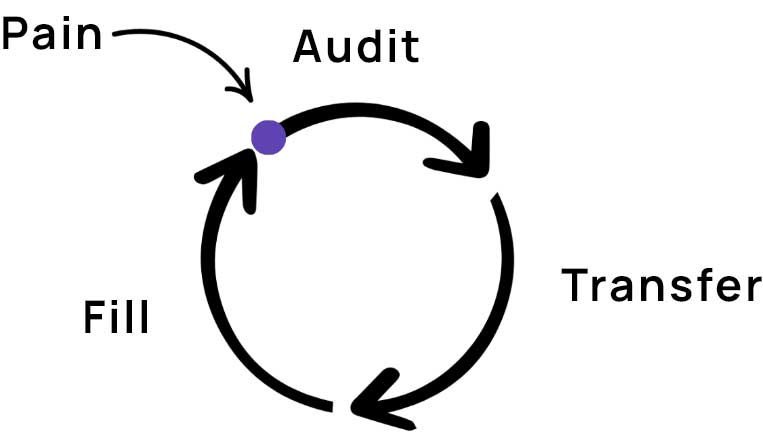7 Golden Concepts from Dan Martell’s “Buy Back Your Time”
-
 Written by:
Filip Pesek
Written by:
Filip Pesek
- Published:

If you’re reading this article, you’ve either already read Dan Martell’s book, Buy Back Your Time, and need a refresher on how to apply its lessons… or you’ve bought the book but can’t find the time to read it-either way, this message is for you.
What is that message? It’s not about grinding harder or squeezing more hours from your day. It’s about shifting your mindset and adopting systems to focus on the high-value work that energizes you and drives results.
Dan’s book teaches you how to trade money for time, buy back your calendar, and achieve success without burnout. The core idea? The Buyback Principle.
“Buyback Principle: Don’t hire to grow your business. Hire to buy back your time.”
~ Dan Martell, Buy Back Your Time.”
If the thought of hiring more people to buy back your time causes you more pain, well, congratulations, you’re ready to elevate your business to the next level. The pain point you reach is a clear indicator that you’ve got a time problem. We use Dan’s book to address the three most common excuses that hold entrepreneurs back from hiring the help they need:
- “I can’t afford it.” (Answer: Understand your Buyback Rate.)
- “It’s too much work to delegate.” (Answer: Follow the Replacement Ladder.)
- “I can’t trust anyone else to do it like I do.” (Answer: Use the 10/80/10 Rule.
If you’ve hit the Pain Line-that pivotal threshold where the frustration of tasks you hate forces you to adapt or stagnate-there’s a better way forward.
In this article we will share 7 Golden Concepts from Dan’s book to help you build a scalable business and a life you love.
Table of Contents
Golden Concept 1: Figure out your Buyback Rate
Every entrepreneur should know their “buyback rate.”
This is the hourly rate at which it makes sense to outsource tasks you’re currently doing.
Here’s how it works:
Take your total income (salary, profits, and discretionary expenses) and divide it by 2,000-the average number of hours a person works in a year. This gives you your hourly rate.
To ensure a good return on investment (ROI), divide that hourly rate by four. The result is your buyback rate. That is, the amount you should pay someone else to handle tasks that free up your time.

For example, let’s say your income last year was $140,000. Divide $140,000 by 2,000 (which is roughly the working hours for the average person in a year) to get $70/hour. Divide that by four, and you get $17.50/hour.
That $17.50/hour is your Buyback Rate-that is what you should pay someone to complete tasks for you. Hiring at this rate gives you a 4X return on investment, which is a phenomenal ROI.
This means you shouldn’t spend your time doing tasks that could be outsourced for $17.50/hour or less. If you do, you’re working against yourself and your goals. Instead, focus on keeping high-value tasks on your plate while delegating low-value, energy-draining work to others. This strategy not only buys back your time but helps you reinvest it into growing your business.
The point Dan Martell makes with this concept of the Buyback Rate, is that if you can hire someone to handle tasks that drain your energy for less than your hourly rate, you should. The freedom this creates allows you to focus on activities that drive revenue and reduce stress-making it a small expense with a huge return.
Golden Concept 2: Execute your buy-back loop and buy back your time
What do you do when you hit the pain line-that breaking point where growing your business feels impossible because your calendar is already bursting at the seams? For some, it’s a looming threat; for others, it’s an everyday reality. The solution is to implement the buyback loop-a simple, repeatable system for hiring people to handle low-value tasks so you can focus on what truly matters.
The buyback loop is a straightforward system comprised of three simple steps:
- Audit: Start with a time and energy audit. Look at everything on your plate and separate the tasks that drain your energy from the ones that fuel it. Focus on identifying low-value tasks—things that you could pay someone else to handle at a fraction of your hourly rate.
- Transfer: Next, take those low-value tasks and offload them. This might mean hiring someone new, renegotiating responsibilities with your current team, hiring a virtual executive assistant or even getting an intern. It doesn’t always have to be expensive, but it does require creativity. The goal is to clear your calendar of anything that doesn’t need your unique skills or focus.
- Fill: Finally, fill the space you’ve created with high-value activities. Spend more time on work you love, focus on tasks that drive revenue, or invest in personal and professional growth. This is your chance to level up by learning new strategies, building scalable systems, or improving traits like consistency or mental strength.

How Do You Execute This Buyback Loop?
Dan Martell suggests starting small: Spend a portion of your income to hire people for minor tasks. This frees up time for high-value work that generates more revenue. As your profits grow, reinvest in hiring for larger tasks, creating even more freedom. This process creates a flywheel of profit, freedom, and fulfillment.
Every time you hit the pain line, run the buyback loop again. It’s a repeatable system that lets you scale your business while building a life you don’t want to escape or retire from.
Practical Application:
Scenario: James spends 20 hours a week dealing with operational chaos—client complaints, staff turnover, and internal approvals.
Action Step:
- Audit: Track his time and identify repetitive, low-value tasks (e.g., approving minor expenses or resolving non-urgent issues).
- Transfer: Delegate client complaints to a customer success manager and administrative tasks to an executive assistant.
- Fill: Use the freed-up hours to focus on systematizing processes and having dinner with his family at least three nights a week.
Result: James reduces his stress and begins reclaiming his personal life while solving high-level business problems more effectively.
Golden Concept 3: Climb the Replacement Ladder
At the top of every business is a bottleneck. It is at the very top of most companies-where the leader, the visionary, the “top gun” sits- where the biggest blockages often form. The bottleneck isn’t somewhere down the chain; it’s you.
Your time, decisions, and inability to delegate effectively create the constraints that keep your business from scaling. But the good news? You have the power to break free and open up the flow-starting with building your team in the right sequence. Delegation, as highlighted in this Forbes article, is a key to unlocking your success.
To achieve true scalability, leaders must systematically transfer responsibilities through the Replacement Ladder.
How can you hire in the right sequence to maximize the impact of your team? It comes down to following a five-step hiring ladder, with each level designed to achieve specific outcomes and free up your time for higher-value work.
Let’s climb the five-step replacement ladder and remove the blocks holding you back.
Level One: Administration Assistant or Executive Assistant
The foundation of scaling is hiring an executive assistant. Remember: million-dollar businesses aren’t built on $60 tasks. By delegating time-consuming activities like managing your inbox, scheduling, booking travel, running errands, or conducting research, you’ll free up your time to focus on growing your business.
Wondering where you will find the perfect Remote Executive Assistant? DonnaPro is the world’s first virtual assistant service specialized exclusively for CEOs and Founders, offering pre-vetted and trained remote assistants that will save you 60 hours per month, every month, without the headache (and pain) of searching for an onboarding one yourself.
Level Two: Delivery
The next step is to hire someone to handle post-sale tasks. This includes fulfillment, customer onboarding, taking payments, or managing customer support. These are crucial operational activities that shouldn’t tie up your calendar.
- Key Hire: Customer success/support staff
Level Three: Marketing
Once delivery is covered, bring in someone to own your marketing efforts. Marketing involves running campaigns, generating leads, and monitoring your traffic-whether online or offline. At this point, it’s no longer the CEO’s job to build and oversee lead generation. You need someone who wakes up every day focused on attracting high-quality, consistent leads.
- Key Hire: Marketing manager or specialist
Level Four: Sales
After marketing, it’s time to hire a salesperson. But timing is everything—don’t do this before your marketing engine is in place. Without a steady flow of leads, your salesperson won’t have enough opportunities to succeed and will likely burn out and quit within months. Hire someone who can handle both initial calls and follow-ups, ensuring smooth conversions.
- Key Hire: Sales representative or manager
Level Five: Executive Leadership Team
The final level is building an executive leadership team. This is where you hire leaders to take over entire functions of your business-whether it’s operations, marketing, sales, legal department or fulfillment. The key here is accountability. These hires should own the strategy, outcomes, and targets of their departments. If you find yourself micromanaging or telling them how to grow their area, you’ve hired the wrong person.
- Key Hire: COO, VP, and/or department heads
By following this sequence, you ensure that every hire frees up your time for higher-value work and positions your business for scalable growth.
This Replacement Ladder allows you to move up in the most efficient way, using the buyback loop to guide each step. It helps founders escape the “job trap” by delegating tasks systematically, allowing them to focus on strategic growth.
Golden Concept 4: Clone Yourself With an Administrative or Executive Assistant (And Buy Back Your Time)

Many entrepreneurs bulk at the thought of handing off tasks that they’ve been doing since the beginning to a new hire. If delegation feels like giving up control, this is the perfect time to reassess your beliefs and shift your mindset on the value of your time.
“If your business depends on you, you don’t own a business-you have a job. And it’s the worst job in the world because you’re working for a lunatic!”
~ Dan Martell, Buy Back Your Time
The first step to doing that is by “cloning” yourself or, in other words, by hiring someone to complete the repeatable, energy-draining, and time-consuming tasks that are dominating your calendar. Your first hire needs to be an administrative (virtual) assistant.
By delegating repetitive, energy-draining tasks, you avoid acting as your own assistant and free yourself to focus on strategic growth. Administrative assistants excel at tasks like managing schedules, handling emails, and solving problems objectively.
Your administrative assistant can likely do these tasks better than you, because they are free from the emotional and psychological hangups that can cause you to procrastinate (there’s that pain line again).
How do Administrative or Executive Assistants buy you more time:
- Taking the heat off tough conversations:
Whether it’s scheduling a tricky meeting with a demanding client or chasing down overdue invoices, assistants handle these tasks with objectivity and professionalism-letting you focus on bigger priorities. - Project management:
Whether it’s tracking deadlines, assigning tasks, or following up with team members, EAs keep your projects moving forward without requiring constant oversight. - Making your calendar and inbox work for you:
From blocking time for deep work to managing email chaos, they’re pros at keeping your day organized and productive. You’ll wonder how you ever got by without their help. - Data analysis and reporting:
EAs can compile, organize, and analyze data, delivering concise reports or dashboards that help you make informed decisions without digging through the details yourself. - Client relationship management:
Your EA can handle routine client interactions, maintain regular follow-ups, and ensure no relationship slips through the cracks—keeping clients happy while saving you time.
By hiring an administrative assistant or an Executive Assistant, you’re not just taking a practical step; you’re taking the first big strategic one to buy back more of your time. This critical step allows entrepreneurs to “clone” themselves by offloading repetitive and draining tasks.
This single investment frees time and energy for high-value, growth-driving activities, making it the primary stepping stone to scalable success.
Practical Application:
Scenario: James spends hours every week juggling an overflowing calendar, responding to countless emails, coordinating meetings, tracking project deadlines, and trying to maintain client relationships—all while barely finding time to think strategically about his business.
Action Step:
- He hires a virtual executive assistant (EA) to take over scheduling, inbox filtering, project tracking, and routine client follow-ups.
- He empowers his EA to streamline communication, coordinate staff updates, and manage logistics, ensuring James is only involved in high-priority decisions.
Result: James saves 10–15 hours a week, freeing him up to leave the office earlier for quality time with his kids or to hit the gym and prioritize his health. With less mental clutter, he can focus on growing his business and regaining balance in his life.
Golden Concept 5: Building The Playbook
A Playbook is a documented process for every key area of your business, ensuring consistent execution and scalability. If you find yourself constantly giving input on repetitive tasks, projects, or systems, it’s time to create one.
What are playbooks, exactly? They are frameworks for predictable results, ensuring a process can be replicated to deliver high-quality outcomes without constant involvement.
How To Create A Playbook
At its core, a playbook is a framework for predictable results without needing your constant involvement. Start by focusing on the area of your business that causes you the most pain, and use the 4 C’s Framework:
The 4 C’s Framework
- Camcorder Method
- Record yourself performing the task using tools like Loom or a phone tripod.
- Do this at least three times to capture any variations in the process.
- Talk through each step as you work to provide clarity.
- Course
- Use transcription tools (like TinyWow) to turn the best recording into text.
- Refine it with AI (e.g., ChatGPT) into a clear, organized procedure document.
- Include both high-level steps and detailed instructions anyone on your team can follow.
- Cadence
- Specify how often the task needs to be performed—daily, weekly, or as needed.
- Checklist
- Create a simple checklist to ensure every step is completed consistently.
- This acts as a quality-control tool, empowering your team to execute autonomously.
Implementing Dan Martell’s 4 C’s concept and creating playbooks for all recurring processes in your company isn’t just about scaling your business but about freeing yourself from the hamster wheel of repeatable processes and systems. This approach minimizes the need for constant oversight, empowers your team, and drives sustainable growth.
Practical Application:
Scenario: Precision ProTech’s manufacturing processes vary, leading to inconsistent quality and repeat problems, and James finds himself doing the same repeatable tasks over and over.
Action Step:
- James uses the Camcorder Method to record key processes, such as equipment maintenance and order fulfillment.
- He converts these recordings into step-by-step guides and checklists for team members, ensuring clarity and consistency.
- Regularly, James reviews and updates the playbook with input from team leads to align processes with company goals.
Result: With standardized processes in place, James reduces his involvement in day-to-day operations, improves team efficiency, and ensures consistent quality across the board.
Golden Concept 6: Follow the 10/80/10 rule
This framework is for anyone who feels their work is too unique or specialized to delegate effectively. Whether you’re a podcaster, an artist, an entrepreneur, or a CEO with a unique vision, the 10/80/10 Rule is a powerful framework to help you stay involved in the parts of your work that matter most while freeing up the bulk of your time.
Here’s how it works:
- The First 10%: Ideation
The first phase is where your expertise and vision are most valuable. This is your time to collaborate with the person or team who will own the process. Share your ideas, explain the desired outcomes, and lay out the key elements of the project. This is where you set the creative direction, establish the “storyline,” and outline the goals. Think of it as planting the seeds for what’s to come. - The 80%: Execution
Once the groundwork is laid, it’s time to step back and let someone else take over. This is where your team (or a trusted individual) moves the project forward—researching, prototyping, outlining, or drafting. Their job is to take your vision and bring it to life by doing the heavy lifting. Whether it’s crafting a marketing campaign, building a product prototype, or drafting a pitch deck, this phase is about translating your ideas into something tangible. - The Final 10%: Integration
The last phase is where you re-enter the process to refine and polish. Just like a chef putting the finishing touches on a dish—garnishing, wiping the plate, and perfecting presentation—you add your unique fingerprint to ensure the final product aligns with your vision. This might mean editing a presentation, adding final creative touches, or delivering the project to clients or stakeholders.
A great example of the 10/80/10 Rule in action is Steve Jobs. He collaborated with Jony Ive on groundbreaking ideas, then trusted the Apple team to handle the bulk of the work: prototyping, sourcing materials, and figuring out how to execute those bold concepts. Jobs would then step back in for the final 10%, refining presentations and demos to perfection before unveiling them to the world.
The beauty of the 10/80/10 Rule is that it allows you to stay involved in the creative or strategic aspects you care most about, while letting others handle the execution. It’s a system that helps leaders, innovators, and visionaries buy back their time without losing their voice or impact on the final result.
Practical Application:
Scenario: Our business owner James wants to develop a new product line for Precision ProTech but feels overwhelmed by the workload.
Action Step:
- First 10%: He outlines the vision, key features, and objectives for the product.
- Middle 80%: Assigns the execution (prototyping, sourcing, testing) to his product development team.
- Final 10%: Reviews and refines the prototype before the launch, ensuring it aligns with his vision.
Result: The owner stays involved in the creative strategy but avoids the grind of day-to-day execution, ensuring the product launch is successful without burning out.
Golden Concept 7: Create your 10x vision map

This framework focuses on four critical areas of your life and challenges you to dream big—far bigger than you might think possible. Why? Because aiming to 10x your life is often easier than trying to 2x it.
Incremental growth forces you to stretch the same resources and mindset, while exponential growth pushes you to rethink everything and create breakthroughs.
Let’s break down how to build your 10x vision:
1. Your Team
To achieve any big dream, it starts with the people you surround yourself with. Your team is the foundation for scaling your vision. Whether it’s your business, your projects, or even your personal life, having the right team in place allows you to get unstuck, reclaim your freedom, and accelerate your growth. Identify the people who can help take things off your plate, amplify your efforts, and move your vision forward.
2. Your Primary Business
Every successful entrepreneur or leader builds wealth and resources by focusing on a primary business. So ask yourself: What is your current focus? Now imagine multiplying that by 10. What does that look like? Not just in vague terms like “better” or “bigger,” but specifics—your team size, revenue, profits, sales, operations, and impact. Most people struggle to paint this picture for the future, but it’s a crucial exercise. When you can clearly see what 10x growth looks like, you unlock the potential for the third area: building your empire.
3. Your Empire
The third key area is your empire—the larger legacy that grows from your primary business. Every great entrepreneur, from Richard Branson to Oprah Winfrey, has either scaled their primary business to new heights, created complementary ventures, or reinvested resources after an exit. Your empire starts by envisioning your business at 10x scale—more leverage, more impact, and more resources.
Entrepreneurs are wired to dream, create, and innovate, not settle. To build your empire, begin by dreaming without limits. Focus on the “what” instead of the “how,” letting your vision be driven by excitement and passion. Then, craft a clear 10x vision: define what success looks like across your team, your business, your broader empire, and your lifestyle.The clearer your vision, the easier it is to stay motivated and take meaningful steps forward. Big dreams lead to big results because they push you to think creatively and tackle challenges in new ways. That’s how ambition turns into a lasting legacy.
4. Your Lifestyle
Finally, it all ties back to your lifestyle. The buyback principle isn’t just for your business; it’s about creating the life you truly want. Be clear about your vision for your personal life. What do you want your days to look like? Where do you want to live? What relationships do you want to nurture? Without this clarity, you risk climbing the ladder of success only to find it’s leaning against the wrong wall. The 10x vision map gives you permission to dream boldly and align your business growth with the life you actually want to live.
This framework offers clarity, direction, and confidence. It helps you envision a future that isn’t just bigger but more aligned with your goals and values. When you focus on these four key areas—your team, your business, your empire, and your lifestyle-you can design a life that’s not only successful but truly fulfilling.
Practical Application:
Scenario: James dreams of scaling Precision ProTech into a €10M business while improving his family life.
Action Step:
- Team: Build a leadership team to oversee operations, sales, and marketing, freeing James to focus on vision and innovation.
- Business: Invest in automation and lean manufacturing processes to reduce operational bottlenecks and improve margins.
- Empire: Create a legacy project, like launching an innovation hub for aspiring entrepreneurs in manufacturing.
- Lifestyle: Redesign his routine to prioritize weekly date nights with Sarah and attending his kids’ school events or sports games.
Result: James transforms his business and lifestyle into something aligned with his values and long-term dreams, becoming both a successful leader and a present family man.
Conclusion: Apply Dan Martell’s Buy Back Your Time Key Concepts to Reclaim Your Freedom
If you’re feeling the pain of lost time with your kids—the ache of missed moments that tug at your heart—while also wrestling with the pain of missed opportunities in your business, you might be asking yourself: Do I have to sacrifice one for the other?
The answer is no.
You don’t have to trade your family’s precious memories for your business ambitions. You don’t have to wait until retirement to escape the pain of the grind and finally live the life you’re dreaming of. You can have both: the thriving business you’ve envisioned and the time to be present with the people who matter most.
By recognizing the Pain Line and adopting the right systems and strategies, you can break free from the false choice between success and family. Scaling your business doesn’t have to mean scaling your sacrifices. Instead, you can build a life where your business fuels your freedom—not your burnout.
The problem isn’t your dream—it’s the way you’re approaching it. By embracing the Buyback Principle, you can shift your mindset and your actions. Scaling your business doesn’t have to mean grinding harder or sacrificing more. Instead, it’s about strategically buying back your time, allowing you to grow sustainably while creating space for what truly matters.
It starts with the Replacement Ladder—hiring your first administrative assistant to take the $10, $50 and $100 tasks off your plate, so you can focus on high-value activities. Through the Buyback Loop, you continuously identify, transfer, and replace low-value tasks, freeing your calendar with each cycle.
With Playbooks, you ensure the systems you build are repeatable and scalable, empowering your team to execute without your constant oversight. The 10/80/10 Rule allows you to stay involved in the creative and strategic work you love while delegating the rest. And with the clarity of the 10x Vision Map, you redefine what success looks like—not just for your business, but for your life.
FAQ
What is a Buyback Rate and how do I calculate it?
Your Buyback Rate is the hourly wage you should pay to outsource tasks. Calculate it by dividing your total annual income by 2,000 hours to get your hourly rate, then divide that hourly rate by four for a 4× ROI.
How does the Buyback Loop help me reclaim time?
The Buyback Loop is a three-step system-Audit, Transfer, Fill. First audit low-value tasks, then transfer them to others, and finally fill the freed time with high-value work that drives growth.
What is the Replacement Ladder and why is it important?
The Replacement Ladder is a five-level hiring sequence-from an executive assistant through to an executive leadership team-that ensures you delegate tasks in the optimal order to scale without bottlenecks.
How do I apply the 10/80/10 Rule when delegating?
The 10/80/10 Rule divides a project into three phases: you contribute the first 10% (ideation), delegate the middle 80% (execution), and return for the final 10% (integration and polish).
What is a 10× Vision Map and how do I create one?
A 10× Vision Map challenges you to envision exponential growth across four areas-team, primary business, empire, and lifestyle-so you set bold targets and align your actions to achieve them.
How can a virtual executive assistant help my business?
A virtual executive assistant can handle scheduling, email management, research, and routine operations, freeing you to focus on high-impact activities. Discover tailored support at DonnaPro homepage.
What tasks can a virtual executive assistant offload from me?
A virtual executive assistant can take over inbox management, calendar coordination, travel arrangements, data entry, client follow-ups and many more. See all offerings in our virtual assistant services or visit our virtual assistant agency homepage.



